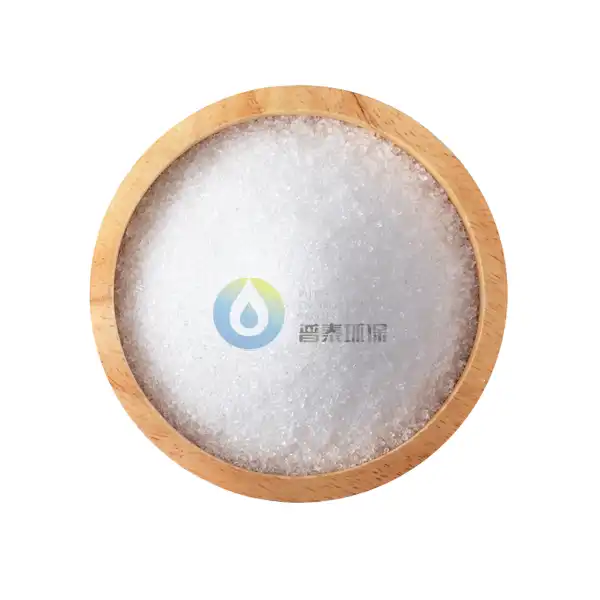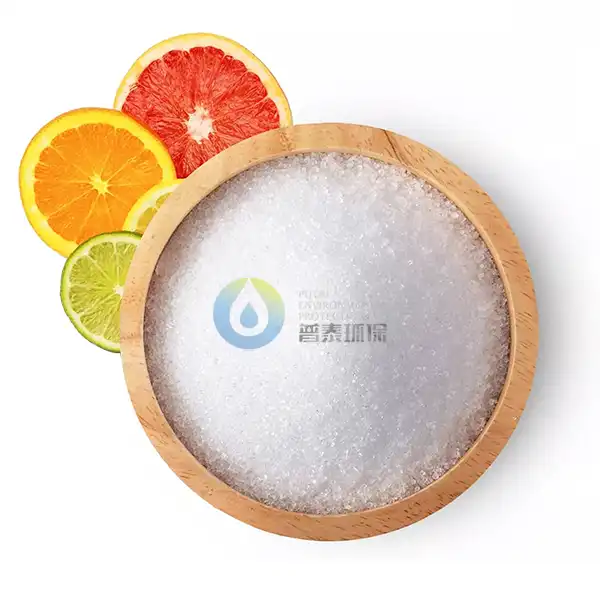How is Citric Acid CAS 77-92-9 produced?
Citric Acid CAS 77-92-9, with the Chemical Abstracts Service (CAS) number 77-92-9, is a versatile organic compound widely used in various industries, including food and beverage, pharmaceuticals, and cosmetics. This blog post will explore the production methods of citric acid, its applications, and the key factors influencing its manufacturing process. Understanding how citric acid is produced is crucial for industries relying on this important compound and for those interested in its widespread use in everyday products.
What are the main production methods for Citric Acid CAS 77-92-9?
Fermentation Process
The fermentation process is the most common and economically viable method for producing citric acid CAS 77-92-9 on an industrial scale. This process utilizes specific strains of mold, primarily Aspergillus niger, to convert sugars into citric acid. The production begins by preparing a nutrient-rich medium containing carbohydrates, typically from molasses or corn syrup. The selected Aspergillus niger strain is then introduced into this medium under controlled conditions. As the mold grows and metabolizes the sugars, it produces citric acid as a byproduct. The fermentation process typically takes 5-8 days, during which parameters such as temperature, pH, and oxygen levels are carefully monitored and adjusted to optimize citric acid production. Once the fermentation is complete, the citric acid is extracted from the fermentation broth through a series of filtration and purification steps, including precipitation, crystallization, and drying, to obtain the final product.
Chemical Synthesis
Although less common than fermentation, chemical synthesis is another method used to produce citric acid CAS 77-92-9. This approach involves a series of chemical reactions starting with simple precursors. One such method begins with the conversion of glucose to pyruvic acid, which is then transformed into citric acid through a series of intermediate steps. Another chemical synthesis route involves the hydration of aconitic acid, which can be derived from citrus fruits or other plant sources. While chemical synthesis offers certain advantages, such as the ability to produce citric acid from non-biological starting materials, it is generally more expensive and less environmentally friendly than the fermentation process. As a result, chemical synthesis is primarily used in specialized applications or when specific purity requirements cannot be met through fermentation-based production of citric acid CAS 77-92-9.
Extraction from Citrus Fruits
Historically, citric acid CAS 77-92-9 was obtained through extraction from citrus fruits, particularly lemons and limes. This method involves pressing the fruits to extract their juice, which is then treated with calcium hydroxide to form calcium citrate. The calcium citrate is then reacted with sulfuric acid to produce citric acid. While this method is no longer widely used for large-scale production due to its inefficiency and higher costs compared to fermentation, it still has some applications in small-scale or artisanal production. The extraction process from citrus fruits can yield a product with a distinct flavor profile, which may be desirable for certain specialized applications in the food and beverage industry. However, the limited availability of citrus fruits and the seasonal nature of their production make this method impractical for meeting the global demand for citric acid CAS 77-92-9.
What are the key factors affecting Citric Acid CAS 77-92-9 production?
Raw Material Selection
The choice of raw materials plays a crucial role in the production of citric acid CAS 77-92-9, particularly in the fermentation process. The primary consideration is the selection of a suitable carbon source, which serves as the main substrate for the microorganisms to produce citric acid. Common carbon sources include molasses, corn syrup, and glucose. The quality and composition of these raw materials can significantly impact the efficiency of the fermentation process and the purity of the final product. For instance, molasses from different sources may contain varying levels of impurities or inhibitory compounds that can affect the growth of the Aspergillus niger strain. Additionally, the nitrogen content and trace element composition of the raw materials must be carefully balanced to support optimal microbial growth and citric acid production. Manufacturers must also consider the availability and cost of raw materials, as these factors can influence the overall economics of citric acid CAS 77-92-9 production.
Process Control and Optimization
Effective process control and optimization are critical for the efficient production of citric acid CAS 77-92-9. In the fermentation process, several parameters must be carefully monitored and adjusted to ensure optimal conditions for citric acid production. These include temperature, pH, dissolved oxygen concentration, and agitation speed. The temperature is typically maintained between 28-30°C, while the pH is gradually lowered from an initial value of around 6.0 to below 2.0 as the fermentation progresses. Adequate oxygen supply is essential for the growth of Aspergillus niger and citric acid production, requiring careful control of aeration rates. Additionally, the concentration of key nutrients, such as phosphates and trace metals, must be carefully managed to promote citric acid synthesis while minimizing the formation of unwanted byproducts. Advanced process control systems, including real-time monitoring and automated feedback loops, are often employed to maintain optimal conditions throughout the production of citric acid CAS 77-92-9.
Purification and Quality Control
The purification and quality control stages are crucial in ensuring the production of high-quality citric acid CAS 77-92-9 that meets regulatory standards and customer specifications. After the fermentation or chemical synthesis process, the crude citric acid must undergo several purification steps to remove impurities and achieve the desired level of purity. These steps may include filtration, ion exchange, activated carbon treatment, and crystallization. The choice and sequence of purification methods depend on the specific production process and the intended end-use of the citric acid. Rigorous quality control measures are implemented throughout the production process, including in-process testing and final product analysis. Key parameters such as purity, moisture content, heavy metal concentrations, and microbiological contamination are carefully monitored. Advanced analytical techniques, such as high-performance liquid chromatography (HPLC) and atomic absorption spectroscopy, are often used to ensure the consistent quality of citric acid CAS 77-92-9 production.
What are the environmental considerations in Citric Acid CAS 77-92-9 production?
Waste Management
Effective waste management is a critical aspect of citric acid CAS 77-92-9 production, particularly in the context of environmental sustainability. The fermentation process, which is the most common method of production, generates significant amounts of organic waste in the form of spent biomass and fermentation broth. Proper treatment and disposal of these waste streams are essential to minimize environmental impact. Many manufacturers implement waste reduction strategies, such as recycling a portion of the fermentation broth or using the spent biomass as animal feed or fertilizer. Additionally, wastewater from the production process must be treated to remove organic compounds and adjust pH levels before discharge. Advanced treatment technologies, such as anaerobic digestion and membrane filtration, are often employed to reduce the environmental footprint of citric acid CAS 77-92-9 production and comply with increasingly stringent environmental regulations.
Energy Efficiency
Improving energy efficiency is a key focus in the production of citric acid CAS 77-92-9, driven by both environmental concerns and economic considerations. The fermentation and purification processes require significant energy inputs, particularly for maintaining optimal temperature conditions, agitation, and downstream processing. Manufacturers are increasingly implementing energy-efficient technologies and practices to reduce their overall energy consumption and associated carbon footprint. This includes the use of heat recovery systems to capture and reuse waste heat from various process streams, the installation of high-efficiency motors and variable frequency drives for pumps and agitators, and the optimization of fermentation conditions to reduce energy requirements. Additionally, some producers are exploring the use of renewable energy sources, such as biogas generated from waste treatment processes, to power their citric acid CAS 77-92-9 production facilities.
Sustainable Raw Materials
The use of sustainable raw materials is becoming increasingly important in the production of citric acid CAS 77-92-9, as manufacturers seek to reduce their environmental impact and meet growing consumer demand for sustainable products. While traditional carbon sources like molasses and corn syrup remain widely used, there is growing interest in exploring alternative, more sustainable feedstocks. These may include agricultural waste products, such as lignocellulosic biomass or food processing byproducts, which can be converted into fermentable sugars for citric acid production. Some researchers are also investigating the use of genetically modified microorganisms capable of utilizing these alternative feedstocks more efficiently. Furthermore, the sourcing of raw materials is being scrutinized to ensure they are produced using sustainable agricultural practices. By focusing on sustainable raw materials, producers of citric acid CAS 77-92-9 can contribute to reducing overall environmental impact and improving the sustainability of their supply chains.
Conclusion
The production of citric acid CAS 77-92-9 is a complex process that involves various methods, with fermentation being the most widely used. Key factors influencing production include raw material selection, process control, and purification techniques. As environmental concerns grow, the industry is increasingly focusing on sustainable practices, including waste management, energy efficiency, and the use of sustainable raw materials. Understanding these aspects is crucial for stakeholders in industries relying on citric acid, as well as for those interested in its widespread applications and environmental impact. As technology advances and sustainability becomes more critical, we can expect further innovations in the production of this versatile compound.
Xi'an Putai Environmental Protection Co., Ltd. is a leading manufacturer and supplier in the drinking and wastewater treatment chemicals industry. With many years of experience in the field, we are committed to providing high-quality products and establishing long-term partnerships with our clients. Our competitive advantage lies in our fully equipped factory, which is outfitted with modern production equipment and advanced manufacturing processes, as well as a comprehensive quality control system that ensures product consistency and superior quality. Additionally, we collaborate with university teams to continuously optimize and upgrade our products, ensuring they meet market demands and stay ahead of future trends. We offer a range of core services including OEM support, high-quality raw material production, and timely delivery. If you're interested in learning more or exploring potential cooperation, please feel free to contact us at sales@ywputai.com. We look forward to the opportunity to work with you.
References
1. Soccol, C. R., Vandenberghe, L. P., Rodrigues, C., & Pandey, A. (2006). New perspectives for citric acid production and application. Food Technology and Biotechnology, 44(2), 141-149.
2. Dhillon, G. S., Brar, S. K., Verma, M., & Tyagi, R. D. (2011). Recent advances in citric acid bio-production and recovery. Food and Bioprocess Technology, 4(4), 505-529.
3. Max, B., Salgado, J. M., Rodríguez, N., Cortés, S., Converti, A., & Domínguez, J. M. (2010). Biotechnological production of citric acid. Brazilian Journal of Microbiology, 41(4), 862-875.
4. Berovic, M., & Legisa, M. (2007). Citric acid production. Biotechnology Annual Review, 13, 303-343.
5. Papagianni, M. (2007). Advances in citric acid fermentation by Aspergillus niger: biochemical aspects, membrane transport and modeling. Biotechnology Advances, 25(3), 244-263.
6. Show, P. L., Oladele, K. O., Siew, Q. Y., Zakry, F. A. A., Lan, J. C. W., & Ling, T. C. (2015). Overview of citric acid production from Aspergillus niger. Frontiers in Life Science, 8(3), 271-283.




